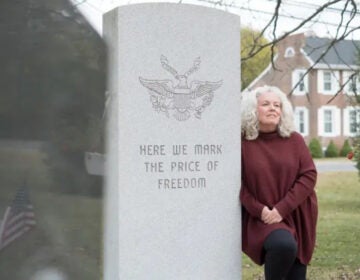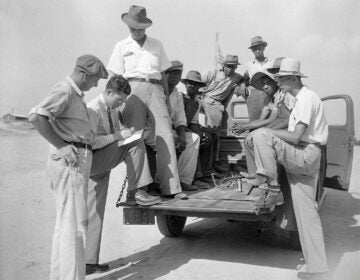Parallel lines go rogue in the artwork of Jim Perry and MOVIS members
The sculpture of Jim Perry is a conundrum of parallel lines. His undulating totems are on view in Maverick Parallels: Sort of Parallel, Definitely MOVIS, on view at Artworks Trenton May 6 through June 13.
MOVIS, a central New Jersey-based artist collective, invited Perry to be a guest artist in the show. “His tall wood totems gracefully and elegantly carry the parallel concept vertically from floor to ceiling,” says MOVIS member Marsha Levin-Rojer.
For Maverick Parallels, parallels may not always behave as expected: sometimes they appear in surprising places; sometimes they may seem to conform but then go a bit awry.
Perry’s works, finely crafted of walnut, mahogany, cherry and cedar, seem to defy reality. In his sculpture, rectangular shapes come together to form curves that twist and bend. They loop into the air like dancers, they enfold each other like lovers, they form vortices and spirals and suggest infinity. The artist himself uses the term “constructing space.”
“Parallel can be defined as having the same direction, course or nature,” says Perry. “So I used this term as a jumping off point to create three individual pieces that are similar in appearance and correspond to each other.”
What about the Maverick part? “Maverick means nonconformist, individualist, free thinker, lone wolf,” he says.
So, then, a maverick is sort of opposite to a parallel line that conforms to the slant of its mate.
Perry’s ideas may or may not parallel the viewer’s interpretation. “Regardless of the artist’s intent, it’s up to the viewer how to see it,” he says. “It’s exciting for me to create new work on this theme since geometry informs all my work with curved lines. I’ve been experimenting with geometry throughout my art career.”
The totems are numbered eight, nine and 10 and made from African mahogany. Each twists 90 degrees from bottom to top, maintaining the parallel structure. The top is on the same plane as the bottom. Pieces overlapping in log cabin fashion are distinguished by darker and lighter tones – the wood is finished with tung oil, bringing out the beauty of the natural color.
Standing seven feet tall, the forms are solid and can endure expansion and contraction of temperature if left outdoors.
“I like the feel of wood, its plasticity, the way it smell and feels,” he says. “I enjoy the process of cutting and assembling pieces to create a finished form. I like that wood is a living substance, comes directly from nature, that its patina changes with time.”
The process begins with a drawing, using an illustrator program, to serve as a construction aid. Although in the end we experience smooth and flowing lines, the process is complicated. No two pieces of wood are exactly the same throughout the piece – there may be a 100th of an inch increment in each layer in order to make it twist.
“I conceive the form in my head and then come up with the math to create the mechanics. It’s all predetermined, there’s not a lot of chance, and it’s always exciting to see it when it’s finished, to see it come together from a vision in your mind.”
Not only must he calculate carefully for all the curves, but for the balance. Each of the totems has the equilibrium to stand on its own, but is mounted on a slate base to guarantee stability in a gallery setting, where passersby could create disturbances.
At home, Perry has also made shoji screens, a desk, dining room table, bed and the kitchen cabinets. The warmth of honey-hued wood permeates the house. He grew up in Erwinna, Pa., and started sculpting in high school. At 14, he knew what he wanted to do. At the Solebury School, he worked in marble and bronze and in 1964, one of his mother-and-child sculptures was accepted into the prestigious Philip’s Mill show.
While studying at Bard College, Perry made the first of his totems in plaster, 15 feet tall. “There’s something about these – I always wanted to go back to working on totems,” he says.
In the early 70s, inspired by minimalist Donald Judd, Perry started working geometric and minimal. In 1974, his “shape that folds over itself again” was accepted into the Whitney Biennial and reviewed by Grace Glueck in the New York Times.
“I am also a minimalist, inspired by the simplicity of form to evoke deeper sensibilities in the viewer,” he says. “I try to hone down to the essence of form, to create, in the end, a piece that expresses something primal, free of adornment.”
Yet despite this passion, Perry gave up sculpture for nearly 30 years to work as a graphics editor for Dow Jones, Merrill Lynch, the Wall Street Journal and, for 28 years, the New York Times, making bar charts and other visual representations. “I didn’t want to do carpentry the rest of my life, and sculpting was so difficult to make a living at,” he says.
He moved to Princeton with his wife, artist Hetty Baiz, raising two sons and commuting. “It was stressful, the daily deadlines, breaking stories and having to do things quickly,” he recounts. When he turned 60 in 2008 and the Times offered a buyout, he took it.
Through all the years, he had ideas incubating. “It wasn’t conscious, it was pent up and coming out in the furniture I made. When I started sculpting again, it moved along rapidly.”
He had a solo show in 2009 at the Morpeth Gallery in Hopewell, and shortly thereafter a show in Houston, Texas. When Princeton Medical Center moved to its new campus in Plainsboro, the hospital commissioned a piece for the lobby.
“While I am ultimately interested in form and shape, texture and rhythm in creating a piece, I also love the process of creating a well crafted piece,” he says. “In this way I feel a kinship with the American sculptor Martin Puryear and feel that I am part of that art making tradition, where craft and aesthetics merge to form the complete whole.”
___________________________________________________
The Artful Blogger is written by Ilene Dube and offers a look inside the art world of the greater Princeton area. Ilene Dube is an award-winning arts writer and editor, as well as an artist, curator and activist for the arts.
WHYY is your source for fact-based, in-depth journalism and information. As a nonprofit organization, we rely on financial support from readers like you. Please give today.










